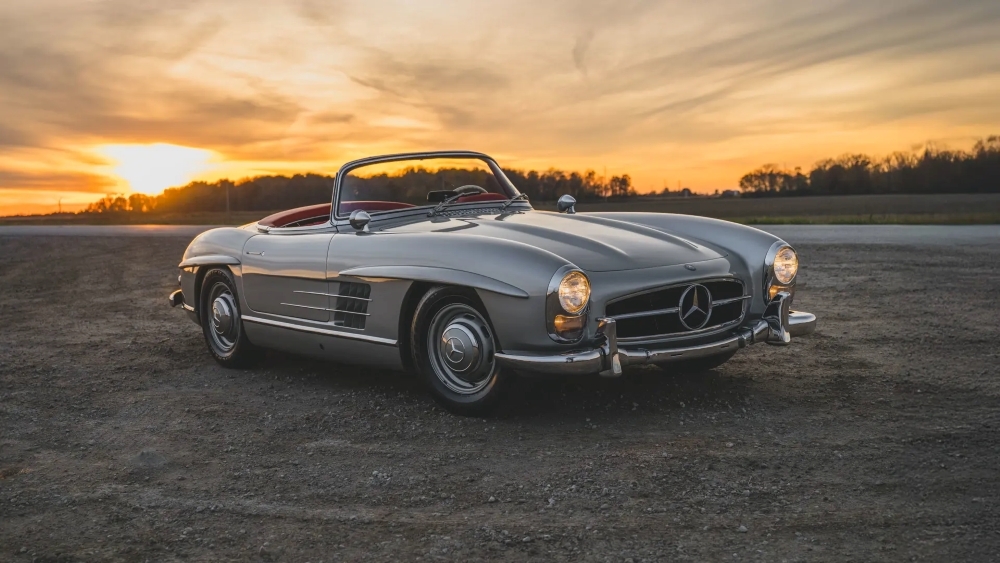Standout Cars from the Indianapolis Motor Speedway Museum at the RM Sotheby’s Miami Auction
RM Sotheby’s, the foremost authority in classic car auctions, partnered with Sotheby’s to introduce ModaMiami in March 2024. This groundbreaking luxury event was a resounding success, celebrating automotive excellence with a mix of auctions, exclusive showcases, high-end retail curated by Sotheby’s, live entertainment, and gourmet dining. ModaMiami returns for its second edition from 27th February to 2nd March at the prestigious Biltmore Coral Gables.
This year’s event will open with a highly anticipated exhibition and auction by RM Sotheby’s, featuring an exceptional selection of rare vehicles from the Indianapolis Motor Speedway (IMS) Museum. Here are three of the most remarkable cars set to go under the hammer.
1966 Ford GT40 Mk II

During the golden age of endurance racing, Ferrari held an unbroken winning streak at Le Mans. Determined to change the narrative, Ford developed the GT40 Mk I, but despite strong performances in 1965, none of its cars finished the race. In response, Ford collaborated with Shelby American and Holman-Moody to create the GT40 Mk II, equipping it with a powerful NASCAR engine, improved aerodynamics, and advanced cooling systems.
This particular GT40 Mk II was entered in the 1966 12 Hours of Sebring, driven by Walt Hansgen and Mark Donohue of Holman-Moody. The pair secured second place, marking Ford’s dominance on the podium and paving the way for a historic Le Mans entry. Tragically, Hansgen passed away before the race, and Donohue was partnered with Australian driver Paul Hawkins. Though technical challenges prevented this specific car from finishing, the GT40 Mk II model secured Ford’s first-ever Le Mans victory, sweeping the top three positions.
After retiring from competition, this GT40 joined the IMS Museum collection in 1968. Restored in 2011 to its original colours and specifications, it remains a significant piece of motorsport history, being one of only eight GT40 Mk IIs ever built.
1908 Mercedes 17.3 Litre 150 HP ‘Brookland’ Semmering Rennwagen

First produced by Mercedes in 1906, this extraordinary car earned its ‘Brookland’ nickname after an impressive performance at England’s Brooklands circuit, the world’s first purpose-built racing track. A special version was constructed in 1908 for Austria’s demanding Semmering Hill Climb, boasting a larger engine than typically permitted in Grand Prix racing. Driven by Otto Salzer, it claimed a decisive victory.
Following its success, the car was returned to Mercedes, where it was upgraded with a 17.3-litre engine producing 150 horsepower—an unprecedented engineering feat. Salzer drove it to victory again in 1909, setting a record that stood unchallenged for 15 years. Later that year, it secured third place in the Champion du Monde, competing against the finest race cars of its era. It was later modified with larger Michelin tyres before being sold to an Australian owner. Over the decades, it changed hands several times in Melbourne, with its seats eventually replaced by metal aircraft seats.
In 1955, automotive enthusiast David Gray Jr. acquired the vehicle. His family was among the earliest investors in Ford, and he was a noted collector. The car remained in his collection until 1964, when it was acquired by the IMS Museum. Meticulously maintained, it has since been showcased at prestigious events such as the Goodwood Festival of Speed in 2003 and the Pebble Beach Concours d’Elegance in 2023. Retaining many of its original mechanical components and its rare factory identification tag, it is one of the most historically significant Mercedes racing cars in existence.
1957 Chevrolet Corvette SS Project XP-64

Designed and developed under the leadership of Zora Arkus-Duntov, often referred to as the ‘Father of the Corvette,’ this extraordinary car was born from a passion for racing. Arkus-Duntov, an automotive engineer with a deep love for motorsport, played a pivotal role in the Corvette’s survival at a critical moment in its history. By 1955, General Motors was considering discontinuing the Corvette, but Arkus-Duntov saw its potential and introduced a re-engineered version that revitalised the model. The new Corvette performed well at the 1956 12 Hours of Sebring, finishing ninth overall and winning its class, leading to a surge in sales.
Recognising the need for a dedicated racing machine, Chevrolet launched Project XP-64, later named the Corvette Super Sport (SS). This lightweight magnesium-bodied prototype incorporated experimental components and cutting-edge technology. Although its debut race was marred by technical issues, forcing its early retirement, the Corvette SS became an icon, frequently displayed at motor shows and featured in leading automotive publications.
Eventually, the car was acquired by the IMS Museum, where it has been preserved as a testament to Arkus-Duntov’s vision and Chevrolet’s ambition to compete at the highest level of motorsport. The Corvette SS remains a legendary creation from one of the most influential figures in the marque’s history, making it a rare and invaluable collector’s piece.



.jpg)